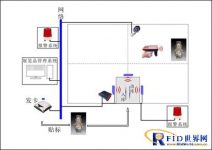
Exhibition management
[ad_1]
1. System background
The theft of exhibits seems to have never stopped, including some famous works. In recent years, more than 250,000 exhibits have been stolen worldwide, and the number of stolen exhibits is increasing year by year. What’s more, only about 5% of stolen exhibits can be recovered. In order to strengthen the security of the exhibits, the RFID anti-theft system is adopted, which greatly reduces the workload in terms of manpower and material resources.
2. System composition
1. Before the exhibits are put into storage: prepare to establish a list of exhibits database;
2. When the exhibits are in the library: Use the handheld RFID reader to make a one-to-one correspondence between the exhibits implanted with RFID tags and the exhibit database list, and set the status of the RFID electronic tags implanted on the exhibits to ” Stored in state”.
3. Outgoing: Exhibits go through a dedicated RFID channel (fixed RFID readers are set up on both sides of the channel), and the RFID tag status of the exhibits implanted with RFID tags is updated to “Already” by the RFID reader when they pass through the dedicated channel. Out of storage status” means that the exhibit has left the warehouse.
4. Transportation: the exhibits are loaded into professional transportation vehicles and transported to the exhibition site;
5. Entry into the exhibition hall: When the exhibits enter the exhibition hall, they enter the exhibition hall through the RFID dedicated channel (fixed RFID readers are set up on both sides of the channel). The RFID tag status of the exhibits implanted with RFID tags is updated to ” “Exhibition status” means that the exhibit has entered the exhibition hall.
6. Exhibition venue monitoring: The network video monitors the exhibits in real time. If the exhibits leave the monitoring area, the video will alarm.
7. Exhibit: Exhibits go through a dedicated RFID channel (fixed RFID readers are set up on both sides of the channel), and the RFID tag status of the exhibits implanted with RFID tags is updated to “Exhibition status” when they pass through the dedicated channel , Which means that the exhibit has left the exhibition hall.
8. Transportation: The exhibits are loaded into professional transportation vehicles and transported back to the warehouse.
9. Storage: Exhibits enter the warehouse through a dedicated RFID channel (fixed RFID readers are set up on both sides of the channel) when entering the warehouse, and the RFID tag status of the exhibits implanted with RFID tags is updated by the RFID reader when passing through the dedicated channel of the warehouse It is “in the warehouse”, which means that the exhibit has entered the warehouse.
3. System advantages
1. Use GPS positioning chip to set up on the dedicated channel of the exhibition hallRFIDThe reader is bound with the GPS positioning system to ensure that the reader on the RFID dedicated channel will not be moved.
2. Once the RFID tag is torn or the exhibits move without application and approval, the system will automatically alarm when passing through the RFID dedicated channel.
3. You can access the WEB server with a fixed IP address through the remote terminal at any time to query the status of the exhibits with RFID tags and call the video surveillance system to view the images of the exhibits at the exhibition site.
Fourth, the system topology

[ad_2]



